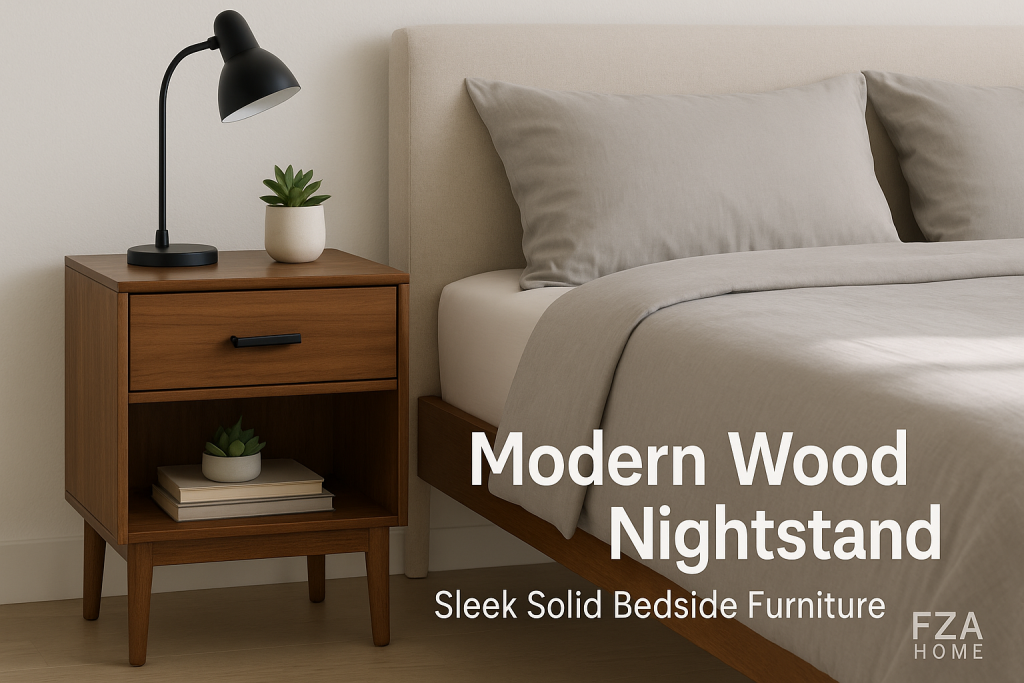
A modern wood nightstand isn’t just a piece of furniture—it shapes the way your bedroom feels, looks, and flows. Designed to serve a purpose while adding a sharp visual note, these nightstands quietly assert their place beside your bed. The combination of natural materials and refined shapes sets them apart from bulkier or more decorative alternatives. They allow you to keep your essentials close while keeping visual noise to a minimum.
This is about smart design, not just surface appeal. Whether you are adjusting your lamp, placing your phone down, or resting a book within arm’s reach, the nightstand plays a reliable role. It becomes a daily companion without demanding attention. A carefully selected sleek bedside table complements more than just your sleeping space—it connects with your larger design direction.
From minimalist apartments to softly toned Nordic bedrooms, a contemporary wooden nightstand slips in with grace. Some designs feature one soft-close drawer, enough to store personal items. Others embrace open formats for a lighter look. The tone is calm, the finish is tactile, and the design feels deliberate. With the right balance of proportion, material, and detail, these tables enhance your bedroom quietly but with purpose.
What Defines a Modern Wood Nightstand?
Clean Lines and Streamlined Silhouettes
Modern nightstands strip away ornamentation. Their lines are straight, surfaces smooth, and shapes precise. These pieces avoid curves and heavy decorative carvings. Instead, they lean into geometry: rectangles, cubes, and floating shapes that align with the bed’s edges. What results is a sense of calm order.
The way a nightstand sits can influence your room’s overall symmetry. A low-profile square with fine legs might create an airy gap beneath it, while a chunky block can ground the bed visually. Designers keep legs minimal or hidden, and edges are softened—not rounded—for safety and subtlety.
This clarity in form supports modern interiors that value simplicity. A clean silhouette blends into space instead of interrupting it. A modern wood nightstand becomes part of the flow, not a disruption. This balance of invisibility and utility defines its success.
Matte Finishes and Subtle Hardware
Gloss is rare in modern wood nightstands. Instead, designers favor matte and satin finishes. These surfaces absorb light instead of reflecting it, which helps them sit quietly within a room. Light oak, ash, and walnut all present well in matte—showing grain without glare.
The same rule applies to hardware. Modern designs avoid flashy handles or metal details. Drawer pulls might be notched into the wood or replaced with a push-to-open mechanism. This allows the piece to maintain its flat, uninterrupted surfaces. Where hardware does appear, it is often brushed or blackened metal—small in size, high in effect, and quiet in tone.
This attention to finish and hardware transforms function into something graceful. A matte black or oak veneer lends the piece a modern feel without sacrificing its warmth. Even a Black and White Bedside Table fits the mold, offering contrast through finish rather than decoration.
Material Choices That Shape Modern Character
Solid Wood and Its Enduring Appeal
There’s weight and character in solid wood. It feels warm to the touch, smells faintly organic, and develops patina over time. Modern designs embrace these qualities without overworking them. The wood speaks through its grain, texture, and slight imperfections. A well-made Real Wood Nightstand ages gently, growing more attractive over the years.
Using solid wood allows for rounded edges, clean seams, and durability that lasts decades. It supports joinery methods like dovetail drawers and mortise-and-tenon legs, which enhance structure without adding bulk. These elements stay hidden but serve a long-term function.
The look of natural wood also connects visually with other parts of your space. A walnut nightstand might mirror the tone of a wood floor or the frame of a mirror. This creates visual cohesion that doesn’t feel forced.
Veneers and Lacquered Surfaces
Not every piece needs to be cut from a single block of wood. Veneers allow designers to experiment with tones, grains, and textures while keeping costs manageable. A high-quality veneer over a durable core can mimic the look of solid wood without the same material cost.
Lacquered finishes add another layer of visual interest. These aren’t high-shine coatings but soft-touch, low-sheen applications. They protect the wood while contributing to its modern appearance. You might see lacquered surfaces in deep black, warm beige, or clean white—perfect for designs like the Black and White Bedside Table.
Veneers and lacquers also allow for cleaner joints and precise edges, reinforcing the minimalist style of the modern nightstand. They help retain shape over time and are easier to clean—important in bedroom furniture that sees daily use.
How Styles Shift Across Interior Aesthetics
Nordic Calm Meets Sleek Functionality
Scandinavian design centers on restraint, natural materials, and soft balance. When applied to nightstands, this results in furniture that feels both approachable and composed. A modern wood nightstand designed in this style typically uses pale wood tones—birch, ash, or light oak—with smooth matte finishes. It’s not loud in appearance; it whispers with clarity and intention.
The Nordic Nightstand is a good example of this design attitude. It carries lightness in form, often with a thin top and tall legs that create breathing room underneath. Its drawer might lack hardware completely, operating through a cutout or push mechanism. This avoids visual clutter and keeps the surface flat and clean.
In Nordic-inspired spaces, every piece earns its place. The nightstand doesn’t compete for attention but instead becomes a calm counterpoint to layered textiles and warm lighting. A single drawer keeps the surface tidy, and the pale grain of the wood helps reflect available light—especially valuable in spaces with limited natural light.
What makes these nightstands appealing is their restraint. They prove that furniture doesn’t need flair to have personality. Through simplicity and natural finish, they feel grounded. When paired with white walls, soft linen bedding, and a neutral rug, they complete a room without trying to dominate it.
Nordic nightstands also work well in small rooms where space is limited. Their lighter look helps keep visual weight down, avoiding bulk near the bed. And their proportions are usually scaled with precision—narrow enough to fit compactly, but tall enough to be functional next to modern low-profile beds.
Urban Interiors and Bold Contrast
Not every space needs softness. Some interiors call for strong visual tension and striking color blocking. A contemporary wooden nightstand in black or dark stain can create that contrast, especially in urban-style bedrooms that mix raw textures and structured forms. These nightstands are less about blending in and more about setting the rhythm of the room.
Urban interiors thrive on material honesty. That means showing the grain through the paint or exposing wood texture even beneath a lacquered surface. A block-style nightstand with a single drawer and recessed pull fits this profile. It’s compact but visually firm, giving the bed a strong anchor without overextending the space.
Color contrast doesn’t have to mean visual chaos. When done with precision, it becomes balance. A black nightstand on one side of a white wall creates harmony through polarity. It becomes a grounding object—a punctuation mark in a space that might otherwise feel too fluid or soft.
These nightstands also bring practical benefit. Their darker finishes tend to hide fingerprints and minor wear, which makes them easier to maintain in high-use environments. And in urban homes where space is tight and every item is chosen for impact, this type of modern wood nightstand delivers both function and a sharp visual edge.
Monochrome and Minimalist Spaces
Minimalist bedrooms favor quiet, deliberate design. Every piece has a function, and visual clutter is actively reduced. Within this mindset, a modern wood nightstand becomes more than just useful—it becomes essential. The best minimalist nightstands rely on proportion, material, and finish to create harmony, not decoration.
These designs often feature a cube or low rectangle shape, with one drawer or an open shelf. They might float—wall-mounted for even more visual lightness—or stand on slim supports. Grain direction runs straight. Hardware is absent or nearly invisible. A minimalist nightstand avoids glossy finishes, instead choosing materials like unfinished oak, stained ash, or soft lacquer.
Minimalism doesn’t mean bland. It means purpose. The nightstand should be the exact size needed—no wider than the bed’s edge, no taller than the mattress line. If it includes storage, it’s hidden. If it holds a lamp, that lamp is simple. Books stack in neat piles. Cables are tucked or channeled.
What results is clarity. A minimalist nightstand allows the mind to settle and rest, free from the visual input of clutter or color noise. Its presence is calm, helping the entire room function better as a place of rest. In this environment, even small design details—like the bevel of a corner or the choice of wood stain—carry meaning.
Storage and Functionality Without Distraction
Single Drawer Simplicity
Sometimes, all that’s needed beside the bed is a drawer to hold the daily essentials—phone charger, journal, maybe a hand cream or a pen. This is where the single-drawer nightstand shines. It provides just enough storage without tipping into excess. Everything you want within reach is close, but out of sight.
Designers understand this need and answer it with quiet solutions. A single drawer, built into a clean-lined box, offers subtle convenience. The drawer may be notched at the top or push-to-open—avoiding visible handles that would break the line of the design. This keeps the piece cohesive and modern.
Solid wood models bring a weight and presence that hold their own beside larger beds. Veneered options in walnut or white oak can offer the same visual character with a lighter construction. Both styles sit well in modern interiors where order and restraint are key.
The drawer adds more than storage—it encourages surface tidiness. When there’s a space to tuck things away, you’re less likely to clutter the top with extras. That leaves room for a lamp, a book, or a small dish for jewelry—items that deserve the space to be seen and used.
Height is critical. A well-designed single-drawer nightstand aligns with the top of your mattress. That way, reaching over in the middle of the night feels natural. Some versions even offer a slightly recessed top, which keeps items from sliding off easily.
Single-drawer nightstands support the balance between minimalism and function. They don’t distract, yet they serve you every day. They stay present without noise—quiet, compact, and always ready.
Open Shelf Designs for Light Storage
Some nightstands remove the drawer entirely. These designs feature an open shelf, which serves both a practical and aesthetic role. Open shelving introduces lightness, making the piece feel less bulky. It also offers immediate access to frequently used items like books, glasses, or headphones.
This format suits minimalist and Nordic styles especially well. The shelf might be flush with the base or set slightly higher, leaving room beneath for a basket or storage box. While it doesn’t hide items the way a drawer does, it invites order in a different way—through clear visibility and accessible layout.
The visual benefit is strong. Open shelves avoid visual blockages. They allow air and light to pass through, helping the room feel more spacious. Especially in smaller rooms, this kind of nightstand prevents that heavy edge that drawers sometimes introduce.
Materials remain consistent—oak, walnut, or stained ash. Surface finish is matte. Edges are squared or gently softened. The shelf can be wood or even tempered glass for an extra layer of lightness.
Functionally, open shelf nightstands work best for those who keep tidy habits. Without a drawer to hide things, it’s essential to be selective about what’s stored. But when managed well, the result is a clean and modern look that supports a relaxed, open environment.
Proportion and Placement Beside Contemporary Beds
Height, Width, and Visual Balance
Getting the proportions right between your bed and nightstand is more than just a matter of convenience. It shapes the flow and symmetry of the entire bedroom. A modern wood nightstand must match not just the aesthetic of your bed but also its height and scale. Without this harmony, even the most beautiful piece can look misplaced.
Contemporary beds tend to be lower than traditional frames. Platform beds, for example, often sit closer to the floor. In these cases, a nightstand should ideally sit level with the mattress top or just a couple of inches above it. If it’s too tall, reaching over in the dark becomes awkward. Too low, and it feels disconnected.
Width also plays a role. The nightstand should be narrow enough to fit the space comfortably but wide enough to hold what you need—a lamp, a book, a glass of water, or your phone. A 16–24 inch range tends to work well for queen-sized beds. For king beds, a slightly wider design may look better balanced.
Placement should follow both utility and visual logic. If your bed is centered on a wall, a nightstand on each side keeps the look grounded. In smaller rooms, even one compact table can offer symmetry if styled with intention. When choosing a minimalist nightstand, its thin profile may even help free up space visually.
Materials and finishes also contribute to proportion. A solid oak nightstand has more visual weight than one made with veneer or open shelving. You can use this to your advantage—heavier pieces for anchoring, lighter ones for floating.
Room Size and Spacing Considerations
Nightstands aren’t just about the bed—they’re about the space around it. In larger rooms, a bigger nightstand with a wider top surface might offer both storage and visual impact. In compact bedrooms, space is tight. Here, the wrong choice can crowd the room and throw off its flow.
Start by measuring the clearance around your bed. You’ll want at least 18 inches between the nightstand and any nearby walls or doors. This allows for movement and prevents the space from feeling cramped. In smaller rooms, floating nightstands or wall-mounted designs save floor space while still offering surface area.
If you’re working with limited square footage, opt for a slender design with an open base. This lets light pass through and avoids creating a visual block beside the bed. A minimalist nightstand with an open shelf, for example, provides storage without feeling heavy.
In larger bedrooms, bulkier designs can offer better proportion. A solid [Real Wood Nightstand] with a full drawer and thick legs might complement a king-sized bed or padded headboard. It adds presence to a big room, especially if other furniture pieces—like dressers or benches—are also large.
Nightstand height should also align with nearby furniture. If you have a tall bed or a high mattress, a taller nightstand makes sense. If your bed is low, a nightstand that’s too high will look and feel disconnected.
Spacing also affects symmetry. In shared bedrooms, two identical nightstands help balance the bed and give both sides equal status. This symmetry is pleasing to the eye and contributes to a calm, orderly atmosphere. But if space or style calls for asymmetry, you can offset one larger table with a smaller stool or shelf—just ensure that visual weight is balanced.
In every room size, the nightstand’s job is to serve—not dominate—the space. And with modern designs, the focus remains on keeping things simple, clean, and practical.
Finishing Touches: The Craft Behind Simplicity
Joinery, Edges, and Grain
The difference between a good nightstand and a great one often comes down to craftsmanship. In modern wood nightstands, where ornament is stripped away, details matter even more. Joinery, edge treatments, and grain direction all influence the look and feel of the piece—subtly but significantly.
Joinery refers to how the parts of the nightstand come together. In high-quality solid wood designs, you might find dovetail joints in drawers. These aren’t just stronger—they signal attention to craft. Mortise-and-tenon or finger joints in the legs and frame provide strength without visible fasteners, preserving clean lines.
Edges play another important role. While traditional furniture may use curves and carved profiles, modern designs favor straight lines with softened corners. A chamfered or beveled edge can reduce the visual sharpness without adding bulk. These softened touches keep the piece feeling human and usable.
Grain direction guides the eye. Vertical grain on drawer fronts elongates the form. Horizontal grain across the top surface expands it visually. Matching grain patterns across panels shows care in construction and respect for the material.
Even the way the grain is treated matters. A matte oil finish brings out depth and character without adding shine. It also allows the wood to breathe and age naturally. On a [Real Wood Nightstand], this kind of finish feels organic and connected to the hand that touches it.
Craftsmanship isn’t loud in modern design. It shows up in how smoothly a drawer slides, how the corners meet, how the finish feels to the fingertips. These are the finishing touches that, though quiet, leave a lasting impression.
Choosing the Right Finish for Your Palette
The right finish can tie your nightstand into the rest of your room or help it stand out in a controlled way. In modern interiors, finishes tend to lean matte or low-sheen, offering a softer, more natural appearance.
Stained finishes offer more control over tone. You can darken walnut, soften oak, or even create grey-washed looks that suit more industrial or urban interiors. These finishes let the grain show while aligning the tone with the rest of your furniture or flooring.
In bedrooms with neutral tones, a natural wood finish adds depth without adding color noise. In spaces with lots of texture—textiles, rugs, wall panels—a soft satin finish can smooth things out visually.
The right finish also makes maintenance easier. Lacquered wood resists moisture better than raw wood, which can be important if you’re keeping drinks nearby. Meanwhile, matte and oiled finishes may show marks but clean up easily with a cloth and care products.
Finishes aren’t just cosmetic—they affect how the piece lives in your space. Choose one that fits both your design and your habits. Whether you want something subtle or something bold, the finish is what brings the nightstand fully into your room’s story.
How to Choose the Best Modern Nightstand for Your Space
Anchoring the Room Without Overpowering It
Choosing a modern wood nightstand goes beyond picking what looks good online. It’s about matching scale, tone, and function to your personal space. A well-chosen nightstand can anchor your bedroom, giving it structure and flow, while a poor fit can throw off the balance.
Start with the bed. Is it low-profile, platform-style, or tall with a thick mattress? Your nightstand should sit as close to the mattress height as possible. This isn’t about rules—it’s about comfort. You want to reach for a glass of water or your phone without reaching down or up awkwardly.
Then look at the width. For tight spaces, a 16-inch-wide nightstand works well. In more spacious rooms, a 20–24 inch option fills the space better and visually balances a wider bed. The thickness of the frame, the openness of the base, and even the color can all affect how heavy or light it feels in the room.
Tone matters too. If your room already has wood floors, consider coordinating or contrasting thoughtfully. A pale oak nightstand may echo a Nordic palette, while a stained walnut or deep charcoal wood gives it weight. The [Real Wood Nightstand] is a strong candidate if you want warmth and presence without flash.
Placement also matters. Does your room have a window next to the bed? Consider a floating nightstand to let more light through. Need storage for cords or books? Look for one drawer with cable cutouts or an open shelf design.
The goal is to find something that fits like it belongs. Not too big. Not too bright. Not too busy. A good nightstand supports the room without shouting for attention—and the best ones feel like they were always meant to be there.
Designing for Daily Use
A nightstand might look minimal and stylish, but if it doesn’t work for your daily life, it will quickly become cluttered or ignored. The ideal modern wood nightstand should serve your bedtime routine while keeping things clean and simple.
Start with the top. What do you usually keep on it? If it’s just a lamp and your phone, a small surface will do. But if you also rest a book, a water glass, and maybe your glasses, you’ll need a bit more space. A top measuring at least 18 inches wide gives you enough room without feeling cramped.
Then there’s storage. If you prefer a tidy space, a drawer is helpful to hide away the essentials. Even a slim single drawer can hold items like earphones, pens, skincare, or medications. Choose models with soft-close runners so drawers glide quietly—an important feature in shared bedrooms.
For those who like to keep things visible, an open shelf design might be more appealing. Just be ready to stay organized. These work well if you like stacking books or keeping baskets for smaller items. But if your habits lean toward clutter, an open shelf might feel messy over time.
Charging your devices? Some modern nightstands come with built-in cable management or USB ports. These tech-friendly options keep cords out of sight and reduce desktop mess. If your nightstand doesn’t include them, look for options with a notch or gap in the back panel so you can thread your cords cleanly.
Finally, think about cleaning and durability. A matte finish hides fingerprints better than high-gloss. A rounded edge prevents painful bumps in the dark. And solid wood handles more wear than a painted or lacquered surface.
Daily use isn’t about just functionality—it’s about ease. When your nightstand supports your routine, your room stays cleaner, and your day starts and ends a little more smoothly.
FAQs
1. What wood is best for a modern wood nightstand?
Solid oak, walnut, and ash are popular for their durability and clean grain. These woods age well and match modern minimalist styles. For a lighter look, choose ash or oak; for warmth and depth, walnut works best.
2. Can minimalist nightstands have storage?
Yes. Many minimalist nightstands include a single drawer or an open shelf. The design remains clean and simple, with hidden hardware or push-to-open mechanisms that keep the look uncluttered.
3. How do I style a black and white nightstand?
Pair it with neutral bedding and monochrome accessories. A soft black lamp, white ceramic dish, or grey-toned book stack can enhance the contrast. Avoid over-decorating—let the color difference stand on its own.
4. Are veneer nightstands durable?
High-quality veneers on a solid or engineered wood base can last many years. They offer stability and resist warping. Just ensure the edges are sealed and avoid exposing them to excessive moisture.
5. How tall should a sleek bedside table be?
Ideally, the top of your nightstand should align with the top of your mattress. This usually falls between 22 and 28 inches, depending on your bed height. This makes reaching for items comfortable and keeps visual balance.











